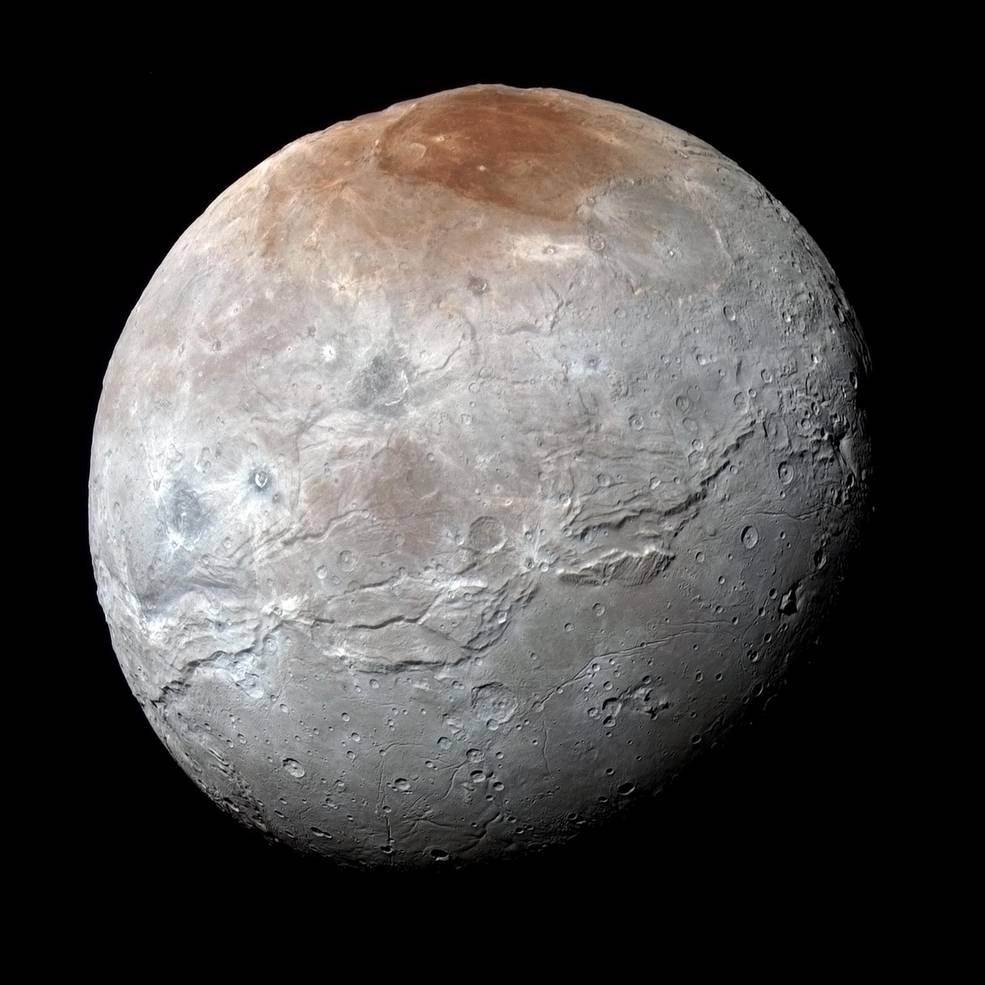Pluto's Moon Charon Had Its Own, Icy Plate Tectonics

Pluto's largest moon, Charon, had a process like Earth's plate tectonics beneath its surface, driven by a freezing ice core that expanded and cracked the little world's crust, researchers said.
Using data from the New Horizons spacecraft, which flew past Pluto and Charon in July 2015, Ross Beyer and his colleagues on the mission team investigated features on Charon's surface to understand how they formed. They noted some similarities to what can be seen back home: Earth's geology is powered by huge plates of crust that float on a taffy-like mantle, crashing into one another. Certain features on Charon seemed to have formed in the same way, the scientists found.
The researchers noticed there were fissures that looked a lot like seafloor-spreading zones or rift valleys on Earth. The scientists also saw depressed blocks of the surface surrounded by faults, called graben, and scarps, where one piece of land had moved vertically relative to the other. [Fly Through Pluto Moon Charon's Giant Canyon in Spectacular New Video]
But the researchers didn't find any evidence of mountain building, a process on Earth caused by tectonic plates colliding.
"What we see are all of these fractures," Beyer, a planetary scientist at NASA's Ames Research Center and a principal investigator at the SETI Institute, told Space.com. "On Earth, where you have plate tectonics, some plates move apart, but they must be colliding in other places, because the Earth is a sphere."
Geological features like the Himalayas are direct illustrations of that collision, which happens because Earth's plates are moving apart in some other location, like the Atlantic Ocean or East African Rift, he said.
In contrast, "on Charon, we only saw the extensional features," Beyer said. "As if the only thing we are seeing is pieces of crust moving away from each other."
Breaking space news, the latest updates on rocket launches, skywatching events and more!
The planetary scientists said they think Charon once had a liquid mantle underneath a crust of mostly water ice. When the ice froze, it expanded, and Charon's crust had to stretch and crack to accommodate that expansion, they said. This doesn't happen with rock like Earth has; most of the time, melted rock will shrink when it becomes a solid.
"Chemically, Charon's surface is super bland, mostly water," Beyer said. Data from New Horizons and earlier observations showed Charon's mean density. That density suggests it likely has a rocky core, or at least that there's some amount of rock in the little moon's makeup, but it would be a minority of the total mass.
Beyer noted that current models depict Charon forming as a result of a proto-Pluto colliding with something big and effectively splitting into two unequal pieces, one of which would become Charon. The initial collision would have generated some heat, and radioactive elements in Charon's core would have generated some more, he said. Initially the surface, made mostly of water with some ammonia, would freeze, but the layer between the rocky core and crust of ice would still be liquid, he added.
Amy Barr Mlinar, senior scientist at the Planetary Science Institute in Tucson, Arizona, told Space.com in an email that tidal forces could also contribute to keeping Charon's underground ocean liquid, though there aren't yet good models for that process in the Pluto-Charon system. And a lot of heat might not be necessary. "A little bit of ammonia (which has been detected on Charon’s surface, I believe) can significantly lower the freezing point of water," she said. "This permits the satellite to have an ocean even if there isn’t much heat available — but Charon should have a decent amount of heat given its high rock fraction."
Regardless of the heat source, Charon is small, with a lot of surface area relative to its volume. Objects with lots of surface area radiate heat away more quickly, which makes it more likely that the liquid mantle finally froze, probably within a few million years. One piece of evidence that the moon froze early is the cratered terrain; the number of craters shows that there hasn't been much geological activity for about 4 billion years at least, the study said.
When Charon's mantle froze, the moon's volume increased, stretching the crust. "So the solution is like a muffin getting bigger," Beyer said. That process built the pattern of ridges and cracks that the scientists saw in the New Horizons images, he said.
The team's research, currently in press, will appear in an upcoming issue of the journal Icarus.
You can follow Space.com on Twitter @Spacedotcom. We're also on Facebook & Google+. Original article on Space.com.

Jesse Emspak is a freelance journalist who has contributed to several publications, including Space.com, Scientific American, New Scientist, Smithsonian.com and Undark. He focuses on physics and cool technologies but has been known to write about the odder stories of human health and science as it relates to culture. Jesse has a Master of Arts from the University of California, Berkeley School of Journalism, and a Bachelor of Arts from the University of Rochester. Jesse spent years covering finance and cut his teeth at local newspapers, working local politics and police beats. Jesse likes to stay active and holds a fourth degree black belt in Karate, which just means he now knows how much he has to learn and the importance of good teaching.
